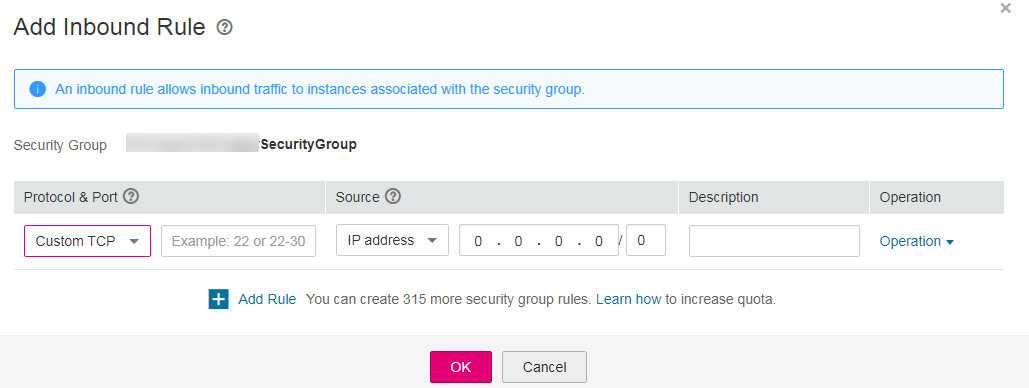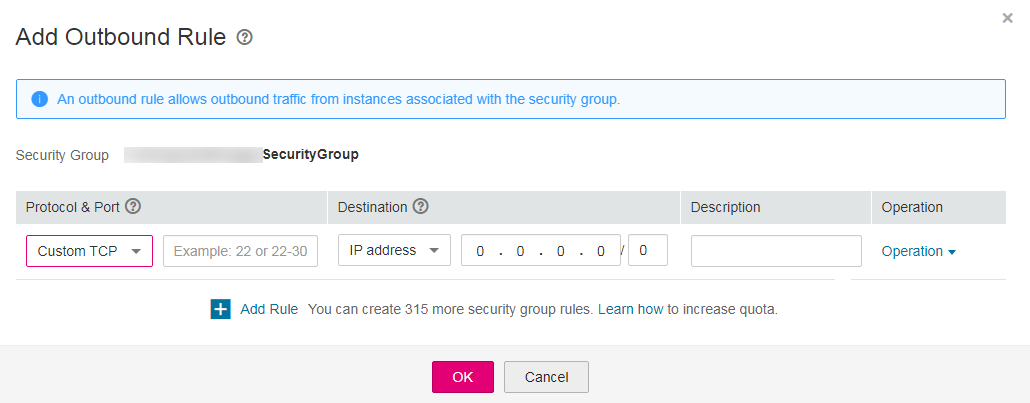Adding a Security Group Rule¶
Scenarios¶
After a security group is created, you can add rules to the security group. A rule applies either to inbound traffic (ingress) or outbound traffic (egress). After ECSs are added to the security group, they are protected by the rules of that group.
Inbound rules control incoming traffic to ECSs associated with the security group.
Outbound rules control outgoing traffic from ECSs associated with the security group.
Procedure¶
Log in to the management console.
Click
 in the upper left corner and select the desired region and project.
in the upper left corner and select the desired region and project.On the console homepage, under Network, click Virtual Private Cloud.
In the navigation pane on the left, choose Access Control > Security Groups.
On the Security Groups page, locate the target security group and click Manage Rule in the Operation column to switch to the page for managing inbound and outbound rules.
On the inbound rule tab, click Add Rule. In the displayed dialog box, set required parameters to add an inbound rule.
You can click + to add more inbound rules.

Figure 1 Add Inbound Rule¶
Table 1 Inbound rule parameter description¶ Parameter
Description
Example Value
Protocol/Application
Specifies the network protocol. Currently, the value can be All, TCP, UDP, ICMP, GRE, or others.
TCP
Port & Source
Port: specifies the port or port range over which the traffic can reach your ECS. The value ranges from 1 to 65535.
22 or 22-30
Source: specifies the source of the security group rule. The value can be another security group, a CIDR block, or a single IP address. For example:
xxx.xxx.xxx.xxx/32 (IPv4 address)
xxx.xxx.xxx.0/24 (subnet CIDR block)
0.0.0.0/0 (any IP address)
0.0.0.0/0
default
Description
Provides supplementary information about the security group rule. This parameter is optional.
The security group rule description can contain a maximum of 255 characters and cannot contain angle brackets (< or >).
N/A
On the outbound rule tab, click Add Rule. In the displayed dialog box, set required parameters to add an outbound rule.
You can click + to add more outbound rules.

Figure 2 Add Outbound Rule¶
Table 2 Outbound rule parameter description¶ Parameter
Description
Example Value
Protocol/Application
Specifies the network protocol. Currently, the value can be All, TCP, UDP, ICMP, GRE, or others.
TCP
Port & Destination
Port: specifies the port or port range over which the traffic can leave your ECS. The value ranges from 1 to 65535.
22 or 22-30
Destination: specifies the destination of the security group rule. The value can be another security group, a CIDR block, or a single IP address. For example:
xxx.xxx.xxx.xxx/32 (IPv4 address)
xxx.xxx.xxx.0/24 (subnet CIDR block)
0.0.0.0/0 (any IP address)
0.0.0.0/0
default
Description
Provides supplementary information about the security group rule. This parameter is optional.
The security group rule description can contain a maximum of 255 characters and cannot contain angle brackets (< or >).
N/A
Click OK.